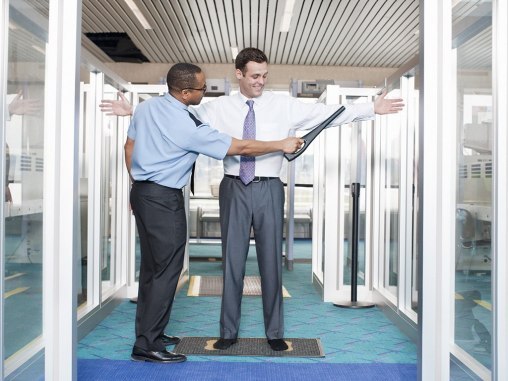By Barbara S. Peterson, CNTraveler.com
With five billion travelers expected to take to the skies within the next 12 years--an increase of about 50 percent over current numbers--international airlines are understandably nervous that the current security strip-tease could bring air travel to a halt. (Or, at least, a very slow slog.) Imagine, then, if you could always keep your shoes on and your toiletries stowed, and simply breeze through a corridor, wheelie in tow, while hidden sensors scan you and your belongings pre-boarding.
That may sound far-out, especially considering that it just takes one scare--like terror groups' threats to disrupt the Sochi Olympics--to ratchet up the TSA friskings. But airlines and security experts are working on a project that potentially could take the pain out of getting to the plane, at least for the vast majority of fliers who are deemed low risk. A coalition of airports and airlines will begin live tests of a "smart security" set-up at Heathrow, Schiphol, and Doha airports, with a prototype expected to launch sometime next year. The goal? Nothing less than an "an uninterrupted journey from curb to aircraft door," says the International Air Transport Association, an industry trade group.
Here's how it works: "Known travelers"--anyone who registers and completes background checks with government authorities in advance--will get expedited access, with the occasional random checks to keep people on their toes. Those include voluntary programs like TSA PreCheck and Global Entry, which offer members a quick trip through security and immigration formalities. A streamlined checkpoint will use cutting-edge technology to clear low-risk fliers without the kabuki dance of removing shoes or cell phones. In its initial phases, carry-on luggage would still be X-rayed on a conveyor belt, but other gizmos using MRI-style technology would function as body and shoe scanners, while new-fangled liquid scanners would let you carry on standard sizes of shampoo and sunscreen.
Those who travel infrequently or simply don't want to submit to a background check could still benefit from the technology as the speed of screenings picks up; the small percentage who get flagged will be screened as they are today. But TSA's hope is that more than 50 percent of travelers will qualify for some form of expedited treatment in the near future.
But if security can be streamlined, then why can't it be made self-service, too? As the rest of air travel increasingly goes the do-it-yourself route (print-at-home baggage tags are soon to be a reality), it's not surprising that tech entrepreneurs see an opportunity. A Palo Alto company called Qylur recently rolled out a Buck Rogers-esque automated checkpoint that looks like a futuristic honeycomb, composed of discrete cells for scanning all manner of items, from your boarding pass to your laptop.
Qylur claims that a single machine with five cells could replace five security lanes, as well as reduce the number of people required to man the checkpoint. Others envision a day when the entire airport will be wired with surveillance cameras that can sense suspicious behavior; there's even something known as a "thermal lie-detector" camera that senses changes in facial temperature when someone is being questioned.
That might sound like an Orwellian nightmare to some travelers, but it's likely that many would embrace a risk-based screening that moves everyone through faster. And that would depend on developing a foolproof biometric chip in passports and travel documents. "We need to make sure the person undergoing the screening is the same as the person on the documents," says Perry Flint, a spokesman for IATA. And while the gadgets may do much of the work, it is unlikely the human element will be removed entirely--officers trained to spot suspicions persons will still play a role. After all, the most sophisticated machines have their limitations when it comes to the ultimate objective: ferreting out the tiny percentage of passengers who pose a true threat.
More from Condé Nast Traveler:
